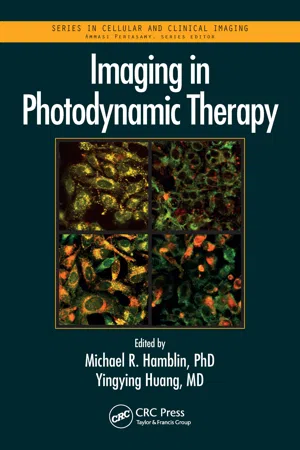1.2.1 LIGHT AS WAVE AND PARTICLE
When we talk about light in this chapter, we are referring to the narrow slice of the spectrum of electromagnetic (EM) radiation that is visible to the human eye (Figure 1.1a). EM radiation, which includes radio waves, microwaves, infrared, visible light, ultraviolet, and x-ray and gamma radiation, is produced when charged particles accelerate, generating electric (E) and magnetic fields (B) propagating through space in a manner that satisfies the set of equations set down by James Clerk Maxwell (1865). For this to be true, the electric and magnetic fields are necessarily sinusoidal in space and time, and mutually perpendicular to the direction of propagation (Figure 1.1b). The descriptive categories of EM waves stated earlier are defined purely on the basis of their frequency, ν, or wavelength, λ, where λν = c. The frequency of a wave is its oscillation rate, typically reported in the SI units of Hertz (Hz), oscillations per second. The wavelength of an EM wave is its propagation distance in a vacuum during a full oscillation cycle (between two adjacent crests or troughs). In a vacuum, all EM radiation propagates at the speed of light, c, approximately 3.00 × 108 m/s, though its speed is different in other media (such as biological tissue). However, although the propagation speed of EM radiation is medium dependent, it maintains the same frequency or wavelength. For the example of an EM wave propagating in the z-direction through a vacuum (empty space), this description can be written more succinctly as
where and are the unit vectors in the x- and y-directions, respectively. The energy carried by EM radiation is reported by the Poynting vector, the vector cross-product of its electric and magnetic fields, with SI units of Watts per meter squared (W/m2). Notwithstanding this universality, however, the physical processes that are relevant to the interaction of EM radiation with matter are indeed highly dependent on wavelength. Hence, our review of the light–matter interaction in the following section will be limited to the discussion of processes that are energetically allowed and relevant for light of visible and near-infrared wavelengths used in PDT and optical imaging, approximately 400–750 nm (Figure 1.1a). For example, this chapter does not deal with effects such as Compton scattering or other important processes more relevant to the interaction of ionizing EM radiation with matter. For a more complete discussion of the basic principles of electrodynamics, the curious reader is referred to any number of texts on this subject, such as the classic by J.D. Jackson (1999).
Yet simultaneously, light can be described as photons, particles that carry discrete packets of energy, E = hν, where h = 6.626 × 10−34 J · s, is Planck’s constant (Einstein 1905). Photons are massless particles and have no electronic charge, but do carry momentum, p = h/λ, such that interactions with other particles are governed by the conservation of momentum. This well-known duality, in which light can be described as both a particle and as a wave, is left over from historic debates on the quantum nature of light and matter in the early twentieth century. Although the wave description is used to describe certain phenomena (coherence, interference, diffraction, etc.) and the particle description is needed for other processes (quantized transitions, photoelectric effect, etc.), both descriptions must always coexist. Indeed, even a single photon can be modeled by wave propagation and, conversely, massive particles such as electrons can also be described as waves, having a de Broglie wavelength, λ = h/p. Here too, in this chapter, we will go back and forth between both descriptions as we discuss the physics of PDT and optical imaging.

